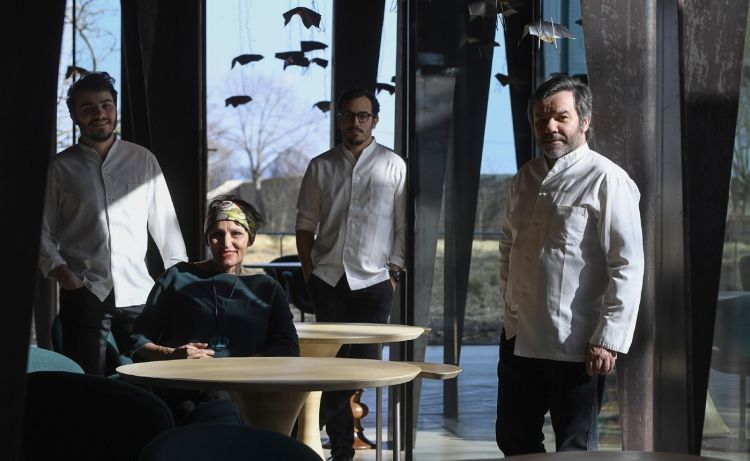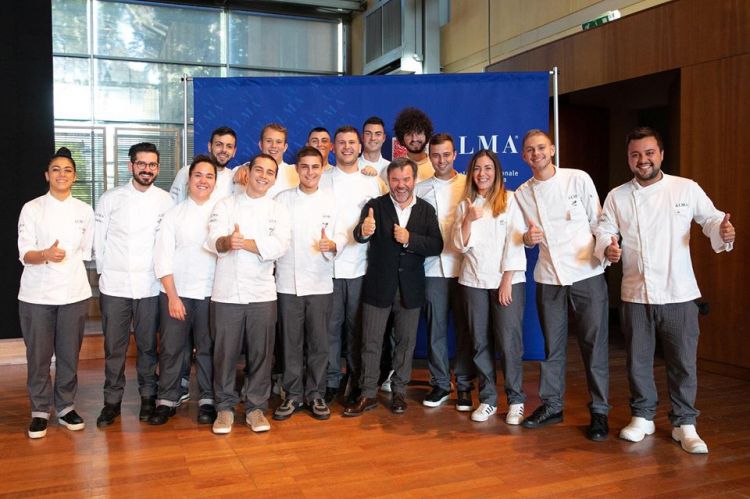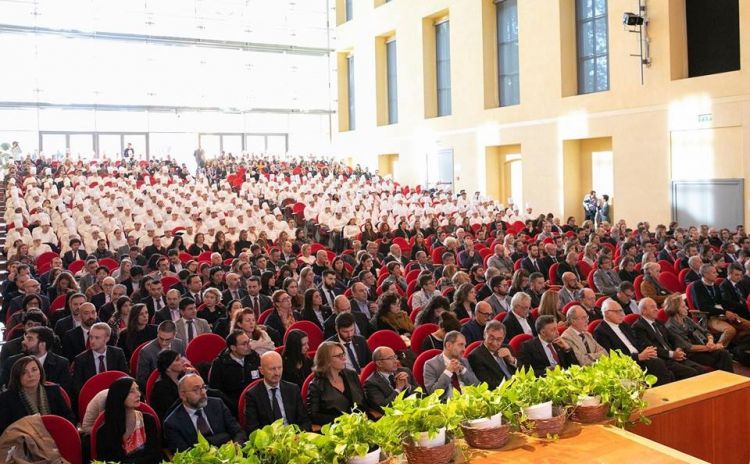When we sit in front of Michel Troisgros – since 1982 the chef at Maison Troisgros, one of the temples of French gastronomy – the chef has just finished his speech in front of the guests invited to the opening ceremony of the 15th academic year at ALMA Scuola Internazionale di Cucina (we wrote about it here –article available in Italian). Troisgros was the guest of honour.
For his speech he decided to speak first of all of his father’s and then his own friendship with the Master of Italian cuisine, Gualtiero Marchesi. It is a known fact that Marchesi spent three months in Roanne with Jean and Pierre Troisgros (Michel’s uncle and father) trying to perfect this style, which then resulted in the revolution that started from Via Bonvesin della Riva.
«I remember when he arrived at the
Maison and for a few months we shared the room above the restaurant’s kitchens. After a day’s work, he would study, read, take notes. He was tireless in his commitment. But on top of his friendship with
Marchesi, the story
Michel Troisgros wanted to tell was that of a strong relationship with Italy and its traditions.
As many readers probably know – it’s a story that Troisgros also recounted in his book “Michel Troisgros et l’Italie”, published in 2009 – his grandmother Anna came from Friuli and was an extraordinary cook. The chef from Roanne drew from her ideas and lessons, so much so he feels «half Italian». Our conversation first began with these inspirations, with the desire to understand where one can find Italy in his current cuisine.
«In my dishes, sometimes you can notice this Italian identity that I feel is a part of me, sometimes you can’t. But I believe it’s always there. Because it’s a part of a whole, of a spirit. Sometimes a dish is born – take my Potato Mezzaluna with Artichoke forinstance– starting from a technique I learnt from my grandmother, as in this case, or which I have recently learnt in Italy. Often enough you can find it in an elegant simplicity, which has always inspired me, and which recently led me to fully reacquire my Italian identity. Perhaps I can explain myself better with an example…»
Such as?
I’ve always admired
Lucio Fontana. Of course today he is very famous, but when I discovered his work, only art lovers and experts knew him in France. Thanks to a show in Paris, I saw his art and in particular his “cuts”. I was deeply touched by his sense of space, without this urging me to try to reproduce what I saw in a dish. I simply interiorised these concepts. Then one day, I was doing a very interesting research on milk, and a dish was born that was very close to
Lucio Fontana’s aesthetics: I didn’t plan to, it was as if my hand and heart followed the inspiration of something I had seen years before and had conquered me. This is also the way in which I express what Italy is for me: I didn’t make a project for that dish, I followed the feelings that came from my idea of cuisine, of art, and in this specific case of milk.
I’d like to return on the concept you mentioned earlier: is simplicity the essential key to interpret your cuisine?
Yes: just like Gualtiero Marchesi, but just like my father too, and my grandmother, I try to make sure that my cuisine is both great and sober, without extravagances. It must show sobriety, but it must shine too.

Michel Troisgros with his wife Marie-Pierre and his two sons Lèo and César. In 2018 Maison Troisgros celebrated 50 years since it received the third Michelin star, which arrived in 1968
When I was a youngster, the greatest lessons came from meeting and working with great chefs. People such as
Alain Chapel,
Frédy Girardet,
Michel Guérard,
Roger Vergé: each one of them taught me a lot when I first began. On the one hand, the basic techniques, but most of all the certainty that what I wanted to do with my life was to become a chef. Even more than my father, my uncle, my grandmother, they were the ones who made me realise that cooking was my life and my passion. My evolution then continued within the family: first the many years working in a pair with my father. Then with my wife and now with my two sons, who have both decided to become chefs. Then I followed the desire to become a part of a dynasty, of a history that does not end. I strongly want it to continue, because I believe it’s a very special story, representing a very rare epopee in France, though perhaps in Italy it would be less rare. Then there were other sources for personal growth of which I became aware only as I became more mature.

With some students from ALMA
I’ve always paid a strong attention to others and this in time has enriched me. When I was young, I wouldn’t have thought so, but it is essential to keep your eyes open and try to understand what’s happening around you. Take architecture, for instance. Today we are in a beautiful building designed by
Renzo Piano [the
Auditorium Paganini in Parma], and I love his work. I’ve visited many of his buildings, I have some of his books, so I paid him a visit in his atelier in Marais. But today I find it thrilling to be here, in this beautiful place. I believe a chef’s sensitivity should be directed to all these things. Chefs should open their minds to art, to other intellectual works, because what a chef does comes from the same inspiration. If you train your capacity of absorbing these stimuli, a great richness will derive of it, namely creativity. To put it very simply, it’s a way of getting new ideas. Can I offer another example?
Of course…
Before, during the ceremony, I was sitting on the stage. I was looking through the large window at the end of the hall: at one point a flock of birds took flight, above the trees, towards the sky. It was a very symbolic moment, given the room was full of young people to whom I would have liked to say “look at what’s happening!”. And the light that passes through the windows of this building made it possible for the shadows of this flock to paint a drawing on the walls of the Auditorium. I was touched and I believe it is important that one preserves their capacity to be touched.

A photo of the audience and of the Auditorium Paganini in Parma, taken from the stage, during the ceremony
Indeed, it is essential. We’ve left behind us decades of abundance, from the post war period up until recently. We weren’t capable of being reasonable. We took too much from this planet, we did not pay attention to how fragile our resources are. We must start from the idea that what for a long time we considered kitchen waste – and I’m speaking of restaurants as well as home cooking -, is not really waste. It’s food, of which we could and should nourish ourselves. For years we’ve taken a nice cabbage and only used the heart. The rest went into the rubbish bin, or in the best case, to feed some animal. We need to understand that all we threw away until yesterday, can be just as good: but we must have the desire to find out how, to work on an idea. Recycling and fighting waste today must be part of the fundamental principles of gastronomy: it is clear that it is feeding the mass that will make the difference, but as chefs we must set the example. Fine dining can no longer be a source of waste, it has to cook everything and show that it is possible, thus contributing in spreading this awareness. If we can’t do this, we won’t be able to save this planet.
Aren’t indeed the expectations of your clients, who want to eat only the best in your restaurants, the greatest obstacle that famous, prestigious chefs like you, with stars on your jackets, face in reaching this goal?
Indeed. You’re right. The audience, our clients, must accept this. It is not easy to have your clients understand this, to make them tell us “Chapeaux” for our efforts. Applying these concepts is a social, intellectual, economic, political commitment. But we also need clients to understand this, because it’s normal for someone who spends 250€ for a meal to expect to find only the heart of the cabbage on their plate. This is why it is important that as chefs we set models, examples. I believe we should all keep in mind an old quote by Gandhi: “Happiness is when what you think, what you say, and what you do, are in harmony”.
Translated into English by Slawka G. Scarso